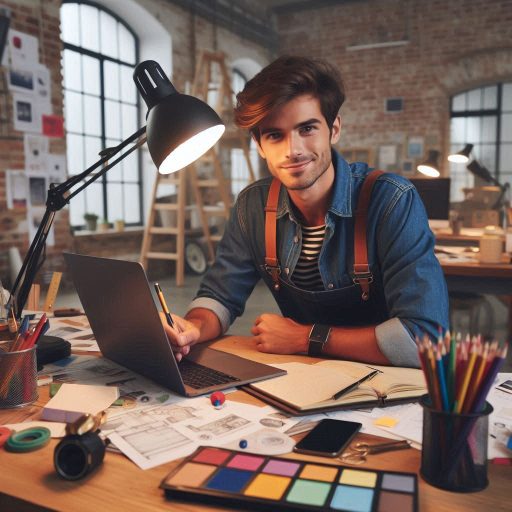Introduction
Exhibition designers play a vital role in the creative industry, serving as the bridge between art, storytelling, and audience engagement.
Their work is essential for transforming spaces into immersive environments that captivate and inspire viewers.
In a world where visual communication is paramount, exhibition designers harness their artistic talents and technical skills to create experiences that leave a lasting impact.
An exhibition designer’s primary role involves conceptualizing and executing designs for various settings, including museums, galleries, trade shows, and corporate events.
They collaborate with curators, artists, and stakeholders to understand the message and theme of the exhibition.
By carefully selecting materials, lighting, and spatial arrangements, they craft environments that not only showcase the content but also evoke emotions and spark curiosity.
Through their innovative designs, exhibition designers engage audiences in unique ways, transforming passive viewing into active participation.
Their work encourages exploration and interaction, making exhibitions memorable experiences that resonate long after the visitor has left.
Research and Education Requirements
The Necessary Educational Background
To become an exhibition designer, a solid educational background is essential.
Most exhibition designers hold degrees in design, architecture, or fine arts.
These fields provide a strong foundation in visual principles and spatial design.
Students learn to think creatively while developing practical skills.
Design programs often cover important topics such as color theory, typography, and layout.
Architecture courses teach students about structural integrity and spatial planning.
Fine arts programs encourage artistic expression and creativity.
Each of these disciplines contributes uniquely to the skill set of an exhibition designer.
The Importance of Gaining Experience
In addition to formal education, gaining hands-on experience is crucial.
Internships or apprenticeships offer practical exposure to the industry.
Many schools encourage students to pursue internships during their studies.
These experiences help students apply their classroom knowledge in real-world settings.
Internships provide valuable opportunities to work with experienced professionals.
Aspiring designers can learn about project management and client relations.
They also gain insight into the design process from conception to execution.
Many internships involve working directly on exhibitions, allowing students to see their ideas come to life.
Apprenticeships can also be beneficial.
Working under a seasoned designer helps refine skills and build confidence.
These arrangements often provide more extensive, hands-on training than internships.
Aspiring designers can immerse themselves in various aspects of the field.
Networking during internships and apprenticeships is vital.
Building relationships with industry professionals can lead to job opportunities.
Attending industry events and joining professional organizations can further expand one‘s network.
Continuous learning is also important in this evolving field.
Designers should stay updated on the latest trends and technologies.
Workshops and courses can help enhance skills and knowledge.
Engaging with design communities online can provide inspiration and support.
Combining formal education with practical experience creates a well-rounded designer.
Students should actively seek out internships and apprenticeships that align with their career goals.
These experiences not only enhance portfolios but also build essential connections.
As aspiring exhibition designers embark on their careers, they should embrace every opportunity for growth.
Each project completed and every skill learned contributes to their development.
With passion and dedication, they can create impactful exhibitions that resonate with audiences.
Read: How to Price Your Ceramic Artwork
Develop Skills and Portfolio
To succeed as an exhibition designer, you need a mix of essential skills.
List Essential Skills
Creativity is the cornerstone of your design work.
You must envision innovative ways to present ideas and themes.
Attention to detail ensures that every element enhances the overall experience.
Small details can make a significant difference in exhibitions.
Proficiency in design software is crucial for modern exhibition designers.
Familiarize yourself with tools like Adobe Creative Suite, SketchUp, and AutoCAD.
These programs help you create detailed layouts and visualizations.
Understanding 3D modeling can also be beneficial for visualizing spaces.
Strong communication skills are vital as well.
You will collaborate with clients, architects, and contractors.
Clear communication helps convey your design vision effectively.
Time management is another essential skill.
You must meet deadlines while ensuring high-quality work.
The Importance of Building a Strong Portfolio
Building a robust portfolio is equally important.
Your portfolio showcases your skills and design philosophy.
Include a variety of projects to demonstrate your versatility.
Feature both completed exhibitions and concept designs.
Each entry should clearly explain your role in the project.
Photographs of your work should be high quality.
Use professional images that capture the exhibition’s essence.
Accompany each image with a brief description.
Explain the project goals, your design approach, and the outcome.
This context helps potential clients understand your thought process.
Consider including sketches and design iterations in your portfolio.
These elements highlight your creative journey and problem-solving skills.
Clients appreciate seeing how your ideas evolved.
Showcasing your ability to adapt is a strong selling point.
Networking can also enhance your portfolio development.
Attend industry events, workshops, and trade shows.
These opportunities allow you to meet professionals and showcase your work.
Engaging with the community can lead to collaborations and referrals.
Additionally, seek feedback on your portfolio from peers and mentors.
Constructive criticism can help you refine your presentation.
Regularly update your portfolio as you complete new projects.
An up-to-date portfolio reflects your growth as a designer.
Finally, consider creating an online portfolio.
A website can expand your reach and attract potential clients.
Make sure it is visually appealing and easy to navigate.
Use social media platforms to promote your work and engage with followers.
In summary, developing skills and building a strong portfolio are vital steps to becoming an exhibition designer.
Focus on honing your creativity, technical skills, and communication abilities.
Showcase your best work in a professional portfolio.
This foundation will help you stand out in the competitive field of exhibition design.
Read: Top Skills Needed for a Successful Character Designer
Network and Collaborate
The significance of networking with professionals in the industry
Networking and collaboration are essential for aspiring exhibition designers.
Building connections with industry professionals opens doors to new opportunities.
These relationships can lead to internships, job offers, and valuable mentorships.
Attend industry events, trade shows, and conferences to meet potential collaborators.
Engaging in discussions with established designers provides insight into best practices and emerging trends.
Networking allows you to exchange ideas with peers.
Join professional organizations or online communities focused on exhibition design.
Participate in workshops and seminars to enhance your skills and knowledge.
Sharing experiences with others fosters a supportive environment where creativity flourishes.
The benefits of collaboration with artists, architects, and other creatives to enhance design projects
Collaborating with artists, architects, and other creatives can elevate your design projects.
Each discipline brings unique perspectives that enrich the design process.
Working alongside artists adds depth and innovation to your exhibits.
Artists infuse emotional resonance into your designs, making them memorable.
Their creative approaches challenge conventional thinking, encouraging you to push boundaries.
Collaboration with architects ensures your exhibitions are both functional and visually striking.
Architects bring technical expertise, helping you navigate spatial constraints and structural requirements.
Teamwork leads to more comprehensive solutions, as each collaborator contributes their skills.
This collaboration fosters a culture of experimentation, often resulting in groundbreaking designs that captivate audiences.
Networking isn‘t just about professional growth; it also nurtures your creativity.
Engaging with diverse minds inspires fresh ideas and innovative approaches.
Attend gallery openings, art shows, and design exhibitions to immerse yourself in the creative community.
Surrounding yourself with creative individuals stimulates your imagination.
Additionally, sharing your work and seeking feedback enhances your design skills.
Constructive criticism from experienced professionals can refine your vision.
Participating in collaborative projects builds your portfolio and showcases your versatility.
Clients and employers value designers who can work effectively in teams.
Networking and collaboration are vital steps in becoming a successful exhibition designer.
Building relationships with industry professionals expands your opportunities and enhances your creativity.
Collaborating with artists, architects, and other creatives brings depth and innovation to your projects.
These connections foster a supportive environment where ideas can flourish.
Embrace networking as a tool for growth, and seek collaboration to elevate your design journey.
Through these efforts, you will develop a distinctive style and stand out in the exhibition design field.
Read: Career Paths in Ceramic Art and Design

Stay Updated on Industry Trends
The importance of staying informed about the latest trends in exhibition design
Staying updated on the latest trends in exhibition design is crucial for success.
The design landscape evolves rapidly, influenced by technology, cultural shifts, and audience expectations.
Understanding these trends helps you create relevant and engaging experiences.
Knowledge of current styles and innovations allows you to stand out in a competitive field.
Being informed enhances your creativity and adaptability.
It enables you to incorporate fresh ideas into your work, ensuring your designs remain appealing.
Clients seek designers who understand modern trends and can apply them effectively.
By staying ahead of the curve, you position yourself as a thought leader in the industry.
Resources for keeping up-to-date with new technologies and design concepts
To keep up-to-date with new technologies and design concepts, leverage various resources.
Subscribe to industry publications and magazines that focus on exhibition design.
Journals often highlight case studies, emerging trends, and expert insights.
Follow influential designers and firms on social media platforms like Instagram, LinkedIn, and Pinterest.
These platforms provide a visual showcase of innovative work and ideas.
Joining online forums and discussion groups can also foster knowledge exchange.
Engaging with fellow designers can lead to valuable discussions about trends and technologies.
Attend webinars and conferences to hear from industry experts.
These events often feature presentations on cutting-edge design practices and tools.
Participating in workshops offers hands-on experience with the latest technologies, enhancing your skill set.
Utilize online resources such as design blogs, podcasts, and video channels.
Websites like ArchDaily and Designboom cover various aspects of design, including exhibitions.
Podcasts often feature interviews with leading professionals discussing current trends and their implications.
Moreover, consider enrolling in courses or certifications that focus on new technologies in exhibition design.
Learning platforms like Coursera and Skillshare offer relevant courses to enhance your knowledge.
Staying updated on industry trends is vital for becoming a successful exhibition designer.
Knowledge of the latest design concepts and technologies keeps your work relevant and innovative.
Utilize various resources, including publications, social media, and workshops, to remain informed.
By actively seeking new information, you will continuously evolve your design skills and stay competitive in the field.
Read: Ceramic Art Exhibitions to Visit in 2024
Gain Practical Experience
Suggest seeking opportunities to work on real-life exhibition design projects
Gaining practical experience is essential for aspiring exhibition designers.
Working on real-life exhibition design projects provides hands-on learning and valuable skills.
Seek internships or entry-level positions with design firms, museums, or galleries.
These opportunities allow you to apply theoretical knowledge in practical settings, enhancing your design capabilities.
Look for projects that align with your interests, whether they involve art exhibitions, trade shows, or corporate events.
Each project offers unique challenges that help you develop problem-solving skills.
Engaging directly with clients and stakeholders also improves your communication abilities, a vital aspect of design work.
The value of participating in design competitions or volunteering for local events
Participating in design competitions can further enhance your practical experience.
Competitions provide a platform to showcase your creativity and technical skills.
They also offer constructive feedback from judges, helping you refine your design approach.
Winning or placing in competitions can boost your portfolio and credibility in the industry.
Volunteering for local events, such as festivals or community exhibitions, is another excellent way to gain experience.
These opportunities often require collaboration with diverse teams, fostering teamwork skills.
Volunteering allows you to contribute to your community while honing your design abilities.
By seeking these practical experiences, you will build a strong foundation for your career in exhibition design.
Each project or competition enriches your understanding of the design process and expands your professional network.
As you gain more experience, your confidence and expertise will grow, paving the way for future success.
Embrace every opportunity to learn and evolve as a designer.
Find Out More: Freelance vs. In-house Product Design Careers
Delve into the Subject: The Future of Virtual Reality in Game Design
Consider Specializing
The option of specializing in a specific type of exhibition design
Considering specialization in exhibition design can be a strategic move for your career.
The field encompasses various areas, including museums, trade shows, and event spaces.
Each specialization has unique requirements, challenges, and design principles.
By focusing on a specific type, you can develop deeper expertise and a more refined skill set.
For instance, museum exhibition design emphasizes storytelling and educational experiences.
Designers in this niche must understand how to engage diverse audiences while preserving artifacts.
On the other hand, trade show design prioritizes brand promotion and product visibility.
This specialization involves creating dynamic spaces that attract attendees and facilitate networking.
Event space design requires a keen understanding of the logistical aspects of gatherings.
Designers must consider factors such as flow, accessibility, and atmosphere.
Specializing in one of these areas allows you to tailor your portfolio and marketing efforts effectively.
How focusing on a niche area can help to stand out in the competitive field
Focusing on a niche area helps you stand out in the competitive exhibition design field.
Specialized knowledge sets you apart from generalist designers, making you more appealing to potential clients.
Businesses often prefer working with experts who understand their specific needs and challenges.
A strong portfolio showcasing your specialization can enhance your credibility and attract targeted clients.
By consistently delivering exceptional work in your chosen area, you build a reputation as a go-to designer.
This reputation can lead to referrals and repeat business, contributing to your long-term success.
Moreover, specializing allows for deeper networking within your niche.
Engaging with industry professionals who share your focus can lead to collaborative opportunities and insights.
You can also stay updated on trends and technologies relevant to your specific area, ensuring you remain competitive.
Considering specialization in exhibition design is a valuable strategy for career growth.
By focusing on areas such as museums, trade shows, or event spaces, you can develop expertise and stand out in the field.
This targeted approach enhances your credibility and opens doors to new opportunities, ultimately leading to a successful and fulfilling career in exhibition design.
Transform Your Career Today
Unlock a personalized career strategy that drives real results. Get tailored advice and a roadmap designed just for you.
Start NowSeek Feedback and Continuous Improvement
The importance of seeking feedback from clients, colleagues, and viewers
Seeking feedback is crucial for growth as an exhibition designer.
Feedback from clients, colleagues, and viewers provides valuable insights into your work.
Constructive criticism helps you identify areas for improvement and refine your design approach.
Engaging with clients allows you to understand their needs better and align your designs with their vision.
Colleagues can offer different perspectives, highlighting strengths and weaknesses you may overlook.
Encouraging open dialogue fosters a collaborative atmosphere, promoting continuous learning.
Viewer feedback is equally important, as it reflects the audience‘s experience.
Understanding how your designs resonate with visitors can guide future projects and enhance overall effectiveness.
Ongoing professional development through workshops, courses, or mentorship programs
Ongoing professional development is essential for staying relevant in the ever-evolving field of exhibition design.
Participate in workshops and courses to learn new techniques, technologies, and design concepts.
These opportunities allow you to enhance your skills and stay updated on industry trends.
Mentorship programs provide another avenue for growth.
Connecting with experienced designers can offer guidance, support, and valuable industry insights.
A mentor can help you navigate challenges and share best practices, accelerating your professional development.
Embrace a mindset of continuous improvement by actively seeking feedback and pursuing learning opportunities.
This commitment to growth will enhance your design abilities and build your confidence.
By focusing on personal and professional development, you position yourself for long-term success in exhibition design.
Always be open to learning and adapting, as this will keep your work fresh and innovative.
Conclusion
Becoming an exhibition designer involves several essential steps that pave the way for a rewarding career.
Start by pursuing a relevant degree in design, fine arts, or a related field.
This educational foundation provides the necessary skills and knowledge to succeed.
Next, focus on building a strong portfolio that showcases your creativity, versatility, and technical abilities.
Include diverse projects that demonstrate your design thinking and problem-solving skills.
Gaining practical experience is crucial.
Seek internships or entry-level positions in design firms to learn from seasoned professionals.
This hands-on experience will deepen your understanding of the exhibition process and refine your skills.
Networking is also key; connect with industry professionals, attend events, and join design organizations to expand your circle.
Stay informed about the latest design trends, technologies, and materials.
This knowledge will enhance your projects and help you create innovative solutions.
Emphasize your unique vision and storytelling ability in your designs, as these elements engage audiences in meaningful ways.
If you are passionate about creating immersive experiences, exhibition design offers exciting opportunities to make a lasting impact.
Your creativity can transform spaces, provoke thought, and captivate visitors.
Embrace your journey with dedication, and continue developing your skills.
Dive into the world of exhibition design, and let your imagination lead you toward a fulfilling and inspiring career!
[E-Books for Sale]
The Big Book of 500 High-Paying Jobs in America: Unlock Your Earning Potential
$19.99 • 500 High-Paying Jobs • 330 pages
Explore 500 high-paying jobs in America and learn how to boost your career, earn more, and achieve success!
See All 500 High-Paying Jobs of this E-Book
1001 Professions Without a Degree: High-Paying American Jobs You Can Start Now
$19.99 • 1001 Professions Without a Degree • 174 pages
Discover 1001 high-paying jobs without a degree! Unlock career tips, skills, and success strategies for just $19.99!




